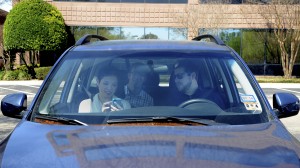
The Texas A&M Transportation Institute (TTI), with support from the Federal Highway Administration’s Value Pricing Pilot Program, recently began a multi-year study to test the use of real-time ridesharing technology to verify the occupancy of a vehicle and to evaluate the effects of toll discounts. The project is being conducted jointly with the Central Texas Regional Mobility Authority (CTRMA) and Carma, a real-time ridesharing vendor.
“Real-time ridesharing differs from old-style carpooling in that it allows people to find ride share matches for carpools any time they want,” said TTI Associate Transportation Researcher Greg Griffin. “It also helps people arrange trips that are outside their regular commute schedule. Traditional carpooling works for Monday through Friday regular commutes, but real-time ridesharing technology uses smartphones with GPS and identity verification to make finding a ride more flexible and secure.”
According to Griffin, the technology works by users accessing a smartphone app to match drivers and potential riders. The app also has a rating system that allows feedback on drivers. What’s the benefit for users? A system that seamlessly allows people to share the cost of their commutes, and potentially get to work faster when used with express lanes managed for high-occupancy vehicles. Also, drivers using Carma get a 50 percent toll reimbursement through their TxTag account if they have one passenger and a 100 percent rebate if they have two or more passengers.
So far, nearly 700 Austin-area residents have downloaded Carma, which is available for download in the Apple App Store using “Carma Carpooling” as a search term.
If successful, this project will pioneer the use high-occupancy toll discounts through real-time ridesharing. The natural pricing incentives of high-occupancy vehicle toll discounts and other benefits could provide a financial incentive for carpooling, in turn mitigating congestion and personal transportation costs.
“If we can connect toll transactions to rideshares, then perhaps there can be incentives, similar to HOV lanes, that can be applied for those to carpool,” said Griffin. “What this means is that if we can provide incentives for carpooling without building new infrastructure, then we can increase the throughput capacity of our existing transportation system.”
For more information about this project, view the Real-time Ridesharing Occupancy Brief.